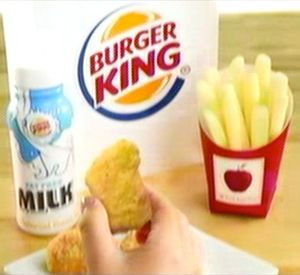McDonald's And Burger King Healthy Kids' Meal Ads Confuse Children About Nutrition

Fast Food companies including McDonald’s and Burger King started advertising healthier meal options for kids back in 2010. The ads' message, however, could be lost on the target audience. Researchers at the Dartmouth-Hitchcock Norris Cotton Cancer Center have concluded a study revealing that children under the age of 10 are mistaking apple slices for french fries and failing to recognize milk as a substitute for soda.
"Burger King's depiction of apple slices as 'Fresh Apple Fries' was misleading to children in the target age range," co-director of the Cancer Control Research Program at Norris Cotton Cancer Center, Dr. James Sargent, said in a statement. "The advertisement would be deceptive by industry standards, yet their self-regulation bodies took no action to address the misleading depiction."
Sargent and his colleagues from the Cancer Control Research Program set out to determine a child’s interpretation of an advertisement depicting healthy kids' meals sold my major fast food establishments. Ninety-nine children from ages 3 to 7 were shown McDonald’s and Burger King ads that aired between July 1, 2010 and June 30, 2011. These commercials were featured on children’s cable networks, such as Nickelodeon and Cartoon Network.
Each child was asked to give an unspecified account of what they interpreted from “freeze frames” of the advertisement. The research team focused their assessment on milk and apple slices, which both McDonald’s and Burger King offer as a part of their healthy kid’s meals. Results of the study found that one-half to one-third of the children included in the research failed to identify milk in both McDonald’s and Burger King’s advertisements.
One child was even willing to admit confusion, saying, "And I see some … are those apples slices?"
"I can't tell you … you just have to say what you think they are," the researcher replied.
"I think they're french fries," the child responded.
Furthermore, only 10 percent of the participants identified Burger King’s sliced apples as actual apples, while the majority of children said they were french fries. A larger portion of the target audience was able to correctly identify McDonald’s apple slices as the fruit. Out of the four images of healthy menu options shown to children, only McDonald’s apple slices were identified by a satisfactory portion of the young television viewers.
"The fast food industry spends somewhere between $100 to 200 million dollars a year on advertising to children, ads that aim to develop brand awareness and preferences in children who can't even read or write, much less think critically about what is being presented," Sargent added.
According to the United States Department of Agriculture (USDA), children aged 3 to 7 should take in anywhere from 1,200 to 1,600 calories each day. ChooseMyPlate.gov, offered by the USDA, is a fun way to help children and their parents control the amount of calories, fat, and protein they take in on a daily basis. Interactive games, videos, and meal trackers make building a healthy meal and maintaining an adequate amount of physical activity easy for children of all ages.
Source: Bernhardt A, Emond J, Sargent J. Children’s Reaction to Depictions of Healthy Foods in Fast-Food Television Advertisements. JAMA Pediatrics. 2014.



























